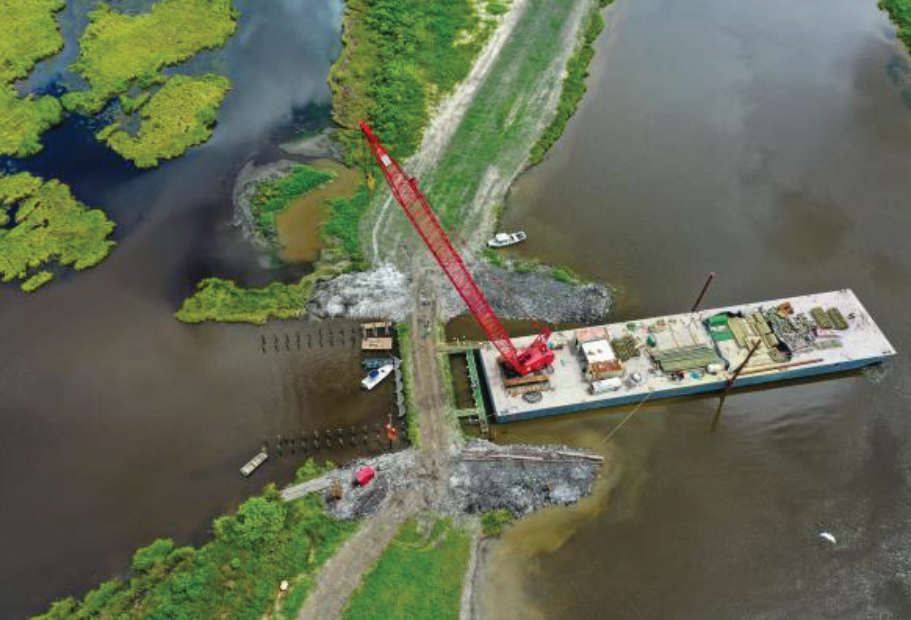Louisiana’s largest sources of money to pay for coastal restoration and protection work will run dry within the next decade, leaving the state far short of the cash needed to fulfill its master plan, respond to climate change and safeguard its residents and businesses.
The state’s Coastal Master Plan currently relies heavily on dollars stemming from the Deepwater Horizon oil spill in 2010 that devastated Louisiana’s coastal ecosystems by spewing millions of gallons of oil into the Gulf of Mexico. Because of the widespread environmental damage, Louisiana received $8.7 billion in settlement and recovery dollars, much of it divvied up from 2017 through 2031 and most of it allocated to coastal work.
That annual support has become essential to paying for Louisiana’s multibillion-dollar, multiyear plan aimed at combatting alarming levels of land loss across southern parishes that is driven by climate change, subsidence, sea level rise, hurricanes, levees constructed around the Mississippi River and other causes.
Projects contained in the master plan target both restoration work and reduction of flood risks, such as water diversions, shoreline protection, marsh creation, vegetative planting and barrier island rebuilding.
Louisiana doesn’t have all the money needed to cover the $50 billion budget estimate needed to finance the master plan. State surpluses, federal hurricane recovery dollars and other revenue sources provide short infusions of cash for the work overseen by the state’s Coastal Protection and Restoration Authority.
But the oil spill money remains the most sizable, dedicated financing stream for the projects – at least until the looming expiration date.
The Deepwater Horizon settlement and recovery agreement involved several pots of money. Among the larger allocations, Louisiana received $5 billion in civil penalties for natural resource damages, more than $1 billion from federal Clean Water Act penalties and nearly $1.3 billion in criminal fines and plea agreements.
Prior to the influx of oil spill settlement dollars, Louisiana had three primary sources of recurring cash to pay for Coastal Master Plan projects: State and federal funding from oil and gas production and federal money from fuel taxes and excise taxes on fishing equipment and boats. Each financing stream can seesaw from external impacts that aren’t in state control, creating uncertainty for the coastal efforts.
Mineral revenues flowing into Louisiana’s coastal trust fund are the only dedicated source of state financing for the restoration and protection work. However, those dollars are unpredictable because of wide fluctuations in oil and gas prices and because of production declines as the nation moves from fossil fuels to alternative energy sources.
The projected revenue available for coastal projects from this source of state oil and gas financing for the current 2022-23 budget year is $13.4 million and next year is $14 million, according to the Coastal Protection and Restoration Authority.
Beyond the dwindling supply of Deepwater Horizon cash, the largest source of ongoing money for Louisiana’s coastal restoration and protection projects comes from a 2006 federal law. The Gulf of Mexico Energy Security Act gave Alabama, Louisiana, Mississippi and Texas – and local governments along their coast – a share of revenue generated by offshore oil and gas production in federal Gulf waters off their shores.
Louisiana is projected to receive $77 million this budget year and $90 million next year from the federal revenue-sharing program, according to the state’s coastal authority. But federal decision- making about offshore oil and gas drilling, such as moratoriums on Gulf leasing programs, impact this significant revenue stream.
A second source of federal financing for coastal work is tied to the 1990 Coastal Wetland Planning, Protection and Restoration Act. That money pays for projects on a reimbursement basis, with the state covering a 15% cost-share for the work.
Louisiana intends to use an estimated $65 million in the current budget year and $46 million next year from the decades-old funding provision, according to the coastal authority’s annual plan. Like the federal revenue-sharing provision, this program’s revenues also fluctuate, tied to fuel taxes, dollars generated by fishing and boating purchases and federal policy choices.
Those three financing sources are the only certain, sustainable money available for coastal restoration and protection when the oil spill money disappears. The dollars from the criminal fines and plea agreements are projected to run out around 2026. Then, the remaining settlement and recovery cash – about $367 million received each year – ends in 2031.
As Louisiana policymakers plan for the future, they must recognize the 2032 fiscal cliff facing the state’s vital coastal preservation work and start deciding how they’ll fill the gap. Targeted dedications of surplus dollars and other short-term cash into Louisiana’s coastal trust fund could be a start, but that clearly won’t be enough.
The state’s economic viability and the survival of its southern parishes depend on the financial decisions elected officials will make to close that gap.
Steven Procopio, president of the Public Affairs Research Council of Louisiana

